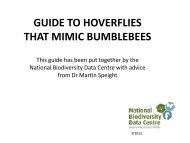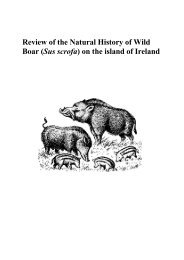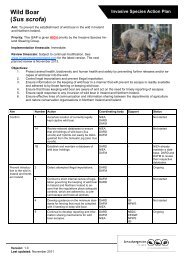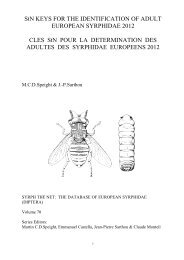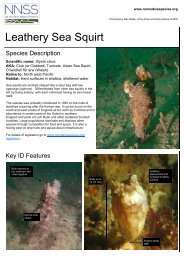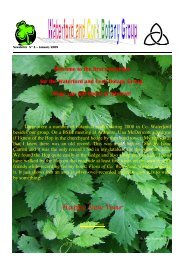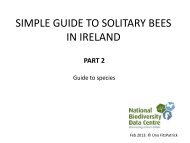StN DATABASE: CONTENT AND GLOSSARY OF ... - Pollinators
StN DATABASE: CONTENT AND GLOSSARY OF ... - Pollinators
StN DATABASE: CONTENT AND GLOSSARY OF ... - Pollinators
Create successful ePaper yourself
Turn your PDF publications into a flip-book with our unique Google optimized e-Paper software.
dune slacks, coastal dunes: CORINE 16.3: HUMID DUNE-SLACKS; humid depressions of the dunal<br />
systems. The most important habitats are included in the following units. If the divisions proposed are<br />
not sufficient, appropriate codes from 22.4,22.3, 54.2, 54.4, 53 can be used in conjunction with them.<br />
Humid dune-slacks are extremely rich and specialized habitats very threatened by the lowering of<br />
water tables.<br />
dwarf Betula/Salix scrub, tundra: dwarf birch (Betula nana) and willow (Salix glauca, S.lanata)<br />
scrub, with a ground vegetation of Arctostaphylos spp., Phyllodoce, Rubus chamaemorus and<br />
Vaccinium spp., developed on mineral-poor soils.<br />
dwarf-heath, tundra: stunted and creeping shrub formations (rarely more than 25cm. high). On sandy<br />
soils ericaceous species (e.g. Arctostaphylos, Phyllodoce, Rhododendron, Vaccinium) often<br />
predominate, together with dwarf Salix (S.glauca, S.lanata), cloud berry (Rubus chamaemorus) and<br />
stone bramble (Rubus saxatile). On neutral, or alkaline soils Dryas heaths are charecteristic, with a<br />
more diverse ground flora, including such species as Draba nivalis, Potentilla nivea, Campanula<br />
uniflora and Arnica alpina.<br />
edge, perm. pool, culture supplementary habitat: the land/water ecotone of small, permanently<br />
flooded, standing-water bodies in cultures (including man-made ponds).<br />
edge, perm. pool in open ground, open ground supplementary habitats: the land/water ecotone of<br />
small, permanently flooded, standing-water bodies in open ground.<br />
edge, perm. pool in wetland, wetland supplementary habitat: the land/water ecotone of small,<br />
permanently flooded, standing-water bodies in wetlands.<br />
edge, perm. pool under canopy, forest supplementary habitat: the land/water ecotone of small,<br />
permanently flooded, standing-water bodies in forests, overshadowed by the tree canopy.<br />
eutrophic/mesotrophic, humid, lowland unimproved grassland<br />
CORINE 37.21: ATLANTIC <strong>AND</strong> SUB-ATLANTIC HUMID MEADOWS; Calthion palustris,<br />
Bromion racemosi, Deschampsion cespitosae; lightly managed hay meadows and pastures on both<br />
basocline and acidocline, nutrient-rich soils of middle European lowlands, hills and low mountains<br />
under Atlantic or sub-Atlantic climatic conditions. Among the characteristic plant components of the<br />
highly diverse communities forming this unit are Caltha palustris, Cirsium palustre, C. rivularis, C.<br />
oleraceum, Epilobium parviflorum, Lychnis flos-cuculi, Mentha aquatica, Scirpus sylvaticus, Stachys<br />
palustris, Bromus racemosus, Crepis paludosa, Fritillaria meleagris, Geum rivale, Polygonum<br />
bistorta, Senecio aquaticus, Trollius europaeus, Lotus uliginosus, Trifolium dubium, Equisetum<br />
palustre, Myosotis palustris, Deschampsia cespitosa, Angelica sylvestris, Oenanthe silaifolia, Gratiola<br />
officinalis, Inula salicina, Succisella inflexa, Dactylorhiza majalis, Ranunculus acris, Rumer acetosa,<br />
Holcus lanatus, Alopecurus pratensis, Festuca pratensis, Juncus effusus, J.fliformis.<br />
CORINE 37.22: SHARP-FLOWERED RUSH MEADOWS; Juncion acutiflori ; Humid meadows<br />
dominated by, or rich in, Juncus acutiflorus. They are floristically and phytosociologically very varied<br />
and many are as related to the oligorophic Molinion communities of 37.3 as to the more eutrophic<br />
Calthion ones of 37.2. Sharp-flowered rush meadows are particularly characteristic of the oceanic and<br />
sub-oceanic regions to the western seaboard of Europe from north-western Iberia to the Low Countries.<br />
CORINE 37.24: FLOOD SWARDS <strong>AND</strong> RELATED COMMUNITIES; Agropyro-Rumicion crispi p.;<br />
grasslands of occasionally flooded river and lake banks, of depressions where rain water collects, of<br />
disturbed humid areas and of pastures submitted to intensive grazing.<br />
Fagus (gen.), deciduous forests: beech (Fagus) forests, with stands of overmature, mature and young<br />
(saplings/scrub) trees. CORINE 41.1.<br />
CORINE 41.1: BEECH FORESTS; forests dominated by Fagus sylvatica or, in Greece, F.orientalis or<br />
F.moesica. Many montane formations are beech-fir or beech-fir-spruce forests, to be noted as 43<br />
(mixed forests), but with the suffixes below; they are discussed with the corresponding deciduous<br />
forests.<br />
Fagus, scattered trees in open ground: see scattered trees in open ground (gen.).<br />
22



